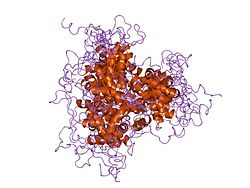Bob
Have a question related to this hub?
Alice
Got something to say related to this hub?
Share it here.
| Fork head domain | |||||||||||
|---|---|---|---|---|---|---|---|---|---|---|---|
 Structure of the winged helix protein Genesis.[1] | |||||||||||
| Identifiers | |||||||||||
| Symbol | Fork_head | ||||||||||
| Pfam | PF00250 | ||||||||||
| InterPro | IPR001766 | ||||||||||
| SMART | SM00339 | ||||||||||
| PROSITE | PDOC00564 | ||||||||||
| SCOP2 | 2hfh / SCOPe / SUPFAM | ||||||||||
| CDD | cd00059 | ||||||||||
| |||||||||||
The fork head domain is a type of protein domain that is often found in transcription factors and whose purpose is to bind DNA.[2]
The fork head protein of Drosophila melanogaster, a transcription factor that promotes terminal rather than segmental development, contains neither homeodomains nor zinc-fingers characteristic of other transcription factors.[3] Instead, it contains a distinct type of DNA-binding region, containing around 100 amino acids, which has since been identified in a number of transcription factors (including D. melanogaster FD1-5, mammalian HNF3, human HTLF, Saccharomyces cerevisiae HCM1, etc.). This is referred to as the fork head domain but is also known as a "winged helix".[3][4][5] The fork head domain binds B-DNA as a monomer,[4] but shows no similarity to previously identified DNA-binding motifs. Although the domain is found in several different transcription factors, a common function is their involvement in early developmental decisions of cell fates during embryogenesis.[5] Members of the class O of forkhead box transcription factors (FoxO) have important roles in metabolism, cellular proliferation, stress tolerance and probably lifespan.[6]